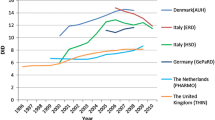Abstract
Use of systemic antibacterial drugs in the countries of central and eastern Europe (CCEE) has been studied using the defined daily doses (DDD) methodology. For the comparison, national wholesale data from Bulgaria, the Czech Republic, Estonia, Hungary, Lithuania, Slovakia, Slovenia and Romania for the years 1989 and 1992 were used, i.e. for the years before and after the rapid sociopolitical changes in these countries. Substantial differences in the patterns of antibacterial drug use between countries as geographically and economically similar as the CCEE were observed. The general sales of antibiotics varied almost twofold among the CCEE and had decreased in most of the CCEE during the study period. The proportion of tetracyclines in the sales of 1992 ranged from 10% in Slovenia to 49% in Estonia, and that of broad-spectrum penicillins from 6% in Estonia to 40% in Slovenia. The use of narrow-spectrum penicillins varied within the range of 4% in Bulgaria to 38% in Slovakia, and had decreased during the study years in all countries. Aminoglycosides accounted for 5–12% of all antibacterials in Bulgaria, Estonia, Lithuania, Romania and Slovakia in the study period, and these countries, with the exception of Slovakia, also had a high consumption of chloramphenicol. In 1992, by far the most popular antiinfectives in the CCEE were doxycycline, ampicillin and co-trimoxazole, which ranked among the top ten drugs in all countries studied. All countries had their specific preferences in the top ten lists, but the rationality of these traditions can be questioned: tetracycline + oleandomycin in Bulgaria; penamecillin in the Czech Republic and Hungary; sulphonamides in Estonia and Lithuania; and benzathine penicillin and streptomycin in Slovakia. The international differences in antibiotic utilization are suggested to be related to the respective health care systems (e.g. drug reimbursement) and prescribing preferences (e.g. therapeutic traditions), quite apart from possible differences in drug efficacy, drug tolerance and the prevalence and severity of various infections.
Similar content being viewed by others
References
Bergman U, Elmes P, Halse M, Halvorsen T, Hood M, Lunde PKM, Sjöqvist F, Wade OL, Westerholm B (1975) The measurement of drug consumption. Drugs for diabetes in Northern Ireland, Norway and Sweden. Eur J Clin Pharmacol 8:83–89
WHO Drug Utilization Research Group (1986) Therapeutic traditions in Northern Ireland, Norway and Sweden. 1.Diabetes. Eur J Clin Pharmacol 30:513–519
WHO Drug Utilization Research Group (1986) Therapeutic traditions in Northern Ireland, Norway and Sweden. 2.Hypertension. Eur J Clin Pharmacol 30:521–525
Kiivet RA, Bergman U, Sjöqvist F (1992) The use of drugs in Estonia as compared to the Nordic countries. Eur J Clin Pharmacol 42:511–515
Llerena A, Vega JS, Kiivet RA (1993) The use of neuroleptics and antidepressants in five European countries. In: Proceedings of the WHO Drug Utilization Research Group 1993 Oxford Conference. Oxford, p 79
Staehr Johansen K, Storgaard M, Carstensen N, Frank U, Daschner FD (1988) An international study on the occurrence of multiresistant bacteria and aminoglycoside consumption patterns. Infection 16:313–322
Kunin CM, Staehr Johansen K, Worning AM, Daschner FD (1990) Report of a symposium on use and abuse of antibiotics worldwide. Rev Infect Dis 12:12–19
Kumana CR, Li KY, Kou M, Chan SC (1989) Cephalosporin and aminoglycoside utilization in different parts of the world. J Antimicrob Chemother 24:1001–1010
Svensk Läkemedelstatistik för »ret 1992 (1993). Apoteksbolaget AB, Stockholm
WHO Collaborating Centre for Drug Statistics Methodology and the Nordic Council on Medicines (1990) Guidelines for ATC classification, 3rd edn. Nordic Council on Medicines, Uppsala
WHO Collaborating Centre for Drug Statistics Methodology and the Nordic Council on Medicines (1991) Guidelines for DDD. Nordic Council on Medicines, Uppsala
Col NF, O'Connor RW (1987) Estimating worldwide current antibiotic usage: report of task force 1. Rev Infect Dis 9:S232-S243
Mölstad S, Hovelius B, Kroon L, Melander A (1990) Prescription of antibiotics to out-patients in hospital clinics, community centres and private practice. Eur J Clin Pharmacol 39:9–12
O'Brien TF, Members of task force 2 (1987) Resistance of bacteria to antibacterial agents: report of task force 2. Rev Infect Dis 9:S244-S260
Howie JGR (1983) Clinical judgement and antibiotic use in general practice. BMJ 272:1061–1064
Author information
Authors and Affiliations
Rights and permissions
About this article
Cite this article
Kiivet, R.A., Bíba, V., Stika, L. et al. Changes in the use of antibacterial drugs in the countries of central and eastern Europe. Eur J Clin Pharmacol 48, 299–304 (1995). https://doi.org/10.1007/BF00198316
Received:
Accepted:
Issue Date:
DOI: https://doi.org/10.1007/BF00198316




